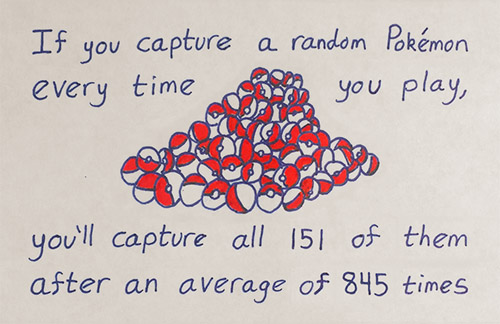
Illustration by Dr. Paul Hand of Unexpecteds.com.
In the game of Pokemon Go, kids and adults alike are going crazy over trying to capture Pokemon by tossing Poke balls (illustration at left). But do you know the math behind the mania?
This problem is a great example of how teachers or parents can make math more fun in the classroom or at home.
By some accounts, there are 151 Pokemon in Pokemon Go, though only 142 have been caught as of July 2016. Some Pokemon are common and some are rare. Some require being in certain geographic locations. Some can be ‘evolved’ from others. Let’s wonder about a simple case. How long would it take to catch all 151 Pokemon if you catch a random one every time you play?
If all 151 Pokemon are equally likely, it will take an average of 845 times in order to catch them all. That uses a lot of Poke balls! This number is so big because most of the time you will get a Pokemon that you already have.
The Coupon Collector Problem
This mathematical problem is known as the Coupon Collector problem. It goes as follows: If there are n coupons, and you get a random coupon every day, how many days until you get one of every coupon? The answer, on average is n times the n-th Harmonic number, where the n-th Harmonic number is the sum 1/1+1/2+1/3 + . . . + 1/n.
In the example of 151 Pokemon, it would take an average of 845 days to collect them all. This number is probably much bigger than what you would have expected.
ACT, SAT, and ISEE students lookout! We’re adapting this problem to be on your next practice set.
This problem is adapted from Unexpecteds.com, which is an illustrated math site by Rice University professor Paul Hand. Dr. Hand updates the site every Thursday with fun ways to bring math alive.



